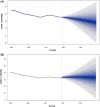Preventable burden of head and neck cancer attributable to tobacco and alcohol between 1990 and 2039 in China
- PMID: 37302807
- PMCID: PMC10394139
- DOI: 10.1111/cas.15877
Preventable burden of head and neck cancer attributable to tobacco and alcohol between 1990 and 2039 in China
Abstract
Tobacco use and heavy alcohol consumption are risk factors for head and neck cancer (HNC), including oral, pharynx, and larynx cancer. No study has investigated the preventable burden of HNC attributable to tobacco and alcohol in China. We extracted data from 1990 to 2019 from the Global Burden of Disease. The preventable burden attributable to tobacco and alcohol was estimated by subtracting the overlapping fraction derived from a literature search. Descriptive analyses were performed initially, followed by joinpoint regression and age-period-cohort (APC) analysis. The future burden was forecasted using a Bayesian APC model. The crude burden increased significantly, while the age-standardized rates showed a downward trend from 1990 to 2019 in China. Both all-age and age-standardized population attributable fractions rose significantly, potentially due to the poor prognosis of tobacco- and alcohol-associated HNC. The absolute burden would continue to climb in the next 20 years from 2019, largely due to population aging. For site-specific burden, compared with total, pharynx, and larynx cancer burden, the substantial upward trend of oral cancer burden indicated a strong interaction with risk factors such as genetic susceptibility, betel nut chewing, oral microbiota, and human papillomavirus. The burden of oral cancer attributable to tobacco and alcohol is a major concern and is anticipated to become more severe than cancer in other anatomic sites. Altogether, our study provides useful information to rethink the current restrictions on tobacco and alcohol, lean healthcare resources, and develop effective HNC prevention and control strategies.
Keywords: age-period-cohort analysis; decomposition analysis; head and neck cancer; preventable burden; tobacco and alcohol.
© 2023 The Authors. Cancer Science published by John Wiley & Sons Australia, Ltd on behalf of Japanese Cancer Association.
Conflict of interest statement
Prof. Youlin Qiao is an associate editor of
Figures





Similar articles
-
Alcohol-related head and neck cancer: Summary of the literature.Head Neck. 2020 Apr;42(4):732-738. doi: 10.1002/hed.26023. Epub 2019 Nov 27. Head Neck. 2020. PMID: 31777131 Review.
-
Tobacco smoking, alcohol drinking, betel quid chewing, and the risk of head and neck cancer in an East Asian population.Head Neck. 2019 Jan;41(1):92-102. doi: 10.1002/hed.25383. Epub 2018 Dec 15. Head Neck. 2019. PMID: 30552826
-
Fraction of head and neck cancer attributable to tobacco and alcohol in cities of three Brazilian regions.Rev Bras Epidemiol. 2018;21:e180005. doi: 10.1590/1980-549720180005. Epub 2018 Aug 2. Rev Bras Epidemiol. 2018. PMID: 30088590 English, Portuguese.
-
The use of tobacco-free betel-quid in conjunction with alcohol/tobacco impacts early-onset age and carcinoma distribution for upper aerodigestive tract cancer.J Oral Pathol Med. 2011 Oct;40(9):684-92. doi: 10.1111/j.1600-0714.2011.01022.x. Epub 2011 Mar 8. J Oral Pathol Med. 2011. PMID: 21385213
-
Alcohol and tobacco use, and cancer risk for upper aerodigestive tract and liver.Eur J Cancer Prev. 2008 Aug;17(4):340-4. doi: 10.1097/CEJ.0b013e3282f75e91. Eur J Cancer Prev. 2008. PMID: 18562959 Review.
Cited by
-
Trends in incidence and mortality of laryngeal cancer in china from 2004 to 2018: Projections to 2033 and decomposition analysis.PLoS One. 2025 Feb 14;20(2):e0318423. doi: 10.1371/journal.pone.0318423. eCollection 2025. PLoS One. 2025. PMID: 39951470 Free PMC article.
-
Age-period-cohort analysis and prediction of tuberculosis trends in China-based on the Global Burden of Disease 2021 data.Front Public Health. 2025 Feb 14;13:1512514. doi: 10.3389/fpubh.2025.1512514. eCollection 2025. Front Public Health. 2025. PMID: 40027502 Free PMC article.
-
Development and validation of a nomogram model for predicting postoperative delirium in elderly patients with oral cancer: a retrospective study.BMC Oral Health. 2025 Jul 2;25(1):990. doi: 10.1186/s12903-025-06167-z. BMC Oral Health. 2025. PMID: 40604666 Free PMC article.
-
Prognostic role of geriatric nutritional risk index (GNRI) and controlling nutritional status (CONUT) on outcomes in patients with head and neck cancer: a systematic review and meta-analysis.BMC Cancer. 2025 Feb 11;25(1):242. doi: 10.1186/s12885-025-13565-7. BMC Cancer. 2025. PMID: 39934700 Free PMC article.
References
-
- Sung H, Ferlay J, Siegel RL, et al. Global cancer statistics 2020: GLOBOCAN estimates of incidence and mortality worldwide for 36 cancers in 185 countries. CA Cancer J Clin. 2021;71(3):209‐249. - PubMed
-
- Pignon JP, le Maître A, Maillard E, Bourhis J. Meta‐analysis of chemotherapy in head and neck cancer (MACH‐NC): an update on 93 randomised trials and 17,346 patients. Radiother Oncol. 2009;92(1):4‐14. - PubMed
-
- Hashibe M, Brennan P, Benhamou S, et al. Alcohol drinking in never users of tobacco, cigarette smoking in never drinkers, and the risk of head and neck cancer: pooled analysis in the international head and neck cancer epidemiology consortium. J Natl Cancer Inst. 2007;99(10):777‐789. - PubMed
MeSH terms
Grants and funding
LinkOut - more resources
Full Text Sources
Medical

